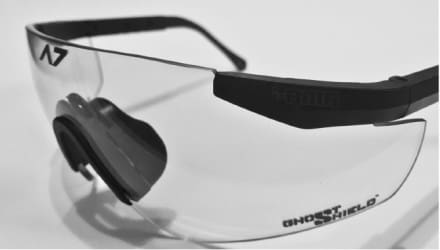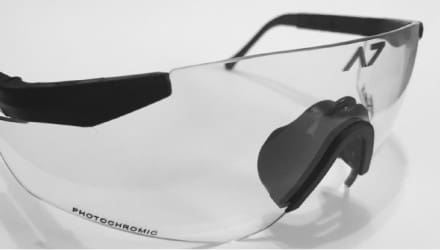Angel 7 Industries, developers of the Ghost Shield light adaptive/photochromic technology, have announced their new ballistic lens technology, i-RMR. This lens technology is capable of a V0 of greater than 1000 feet per second and a V50 of almost 950 feet per second. The full release can be read below:
Angel 7 Industries, LLC.(A7) has developed a next generation, versatile, and enhanced ballistic lens technology called i?RMR™. which has recently completed testing in accordance with ANSI Z87.1?2010, EN 166 and U.S. military ballistic impact requirements for spectacles (MILPRF-32432, clause 4.4.3.3.4, superseding former MIL?PRF?31013, clause 3.5.1.1.) and goggles (MILPRF-32432, clause 4.4.3.3.5, superseding former MIL-DTL-43511D, clause 3.5.10). The test results showed that the new lens technology achieved a V0 of greater than 1000 feet per second and a V50 of almost 950 feet per second! i-RMR™ lens technology has achieved these remarkable results without increasing lens thickness or weight and while maintaining perfect optical clarity. This new lens technology is a patents-pending, proprietary process that not only drastically increases the protective capability of a lens, it also allows A7 to combine other lens technologies in various and unique combinations in the manufacturing process which eliminates costly and time consuming secondary steps. i-RMR™ lenses can be combined with laser absorbing dyes, with polarization, with high definition solutions or any combination of these options. The process is completely automated which ensures consistent quality and drastically speeds up production time while reducing waste in comparison to traditional “flow coating” methods.
A7’s new Ghost Shield™ light adaptive/photochromic technology is one of the various lens enhancements that can be combined with i-RMR™ technology. Ghost Shield™ photochromic technology is greater than 90% clear (VLT) in it’s unactivated state and automatically adapts (tints) to any lighting condition in less than 10 seconds. The proprietary manufacturing process actually embeds the photochromatic material directly into the lens material so that there is nothing to scratch off and nothing that can be affected by sand, dirt, mud, or chemicals. The value proposition to an operator is twofold; 1. The operator now can utilize the most ballistically capable lens technology in the industry and 2. One Ghost Shield™ lens takes the place of both a clear and a tinted lens which means one less piece of gear to carry and keep up with, and less cost to agencies.
Tags: Angel 7 Industries




Good timing! Waiting on my voucher to get prescription.
It’s this available to consumers at this time? If so, which eye pro companies are carrying this technology ( Smith Optics only)?
Does the light adaptive/photochromic technology work in a vehicle? The ones I have don’t because the slight tint added to car windows (US) reduces UV enough to keep the sunglasses from working.
How dark do they get, again my photochromic lenses do not seem to get as dark as my Oakley’s.
Liquid Eyewear is also doing this and has been for some time, they call it their Hellfire lens. Great piece of kit…
http://www.liquidpolarized.com/ltd.html
My Rudy projects work great
Thanks for all of the support and questions. To aid the discussion, i-RMR is the foundation of all of our proprietary lens tech, and Ghost Shield is our next-gen photochromic lens tech. You can get our lenses with i-RMR only which accomplishes a V0 @ over 1000 fps and a V50 of almost 950fps. If you can find any eyewear that even comes close to that, I highly recommend you buy it. Our photochromic is COMBINED with i-RMR and is the fastest light adaptive technology in the industry. Ghost Shield transitions in under 10 seconds and reverts back to clear in less than 2 minutes. Clear VLT is greater than 90% and tinted is 13%. It’s light adaptive meaning that the brighter it is outside, the darker the lens and vice versa. We know Ghost Shield transitions faster than any other photochromic lens in the industry because we compared it to everything in the industry under controlled, 3rd party conditions. Ghost Shield even tints moderately behind windscreens. The Apollo glasses will be available shortly and we have several combinations including HD photochromic, mirrored photochromic (usable in low light and transforms into a mirror in the sun) POLTAC(LCD screen compatible) and LEP photochromic. Advanced ballistics and extreme versatility is what we have accomplished with regards to the operator. Again, thanks for the questions and looking forward to providing you guys with the most versatile, ballistically advanced eyewear systems on the planet.
Regarding the liquid eyewear post, I think you ought to read your own specs from the link you posted. It’s not even close.
Rudy project photochromic, I believe, are made by Transitions aren’t they? Around 78% VLT, takes almost 30 seconds to tint and over 5 minutes to go back to clear. Again, not even close.
Where can these be purchased and what is the estimated MSRP for the glasses shown?
AK,
Please send us an email at inquiries@angel7industries.com and our salespeople will take care of you.
Is anyone even remotely familiar with ballistic specs here? A V50 test is performed to determine a velocity where 50% of the threats will penetrate the lens. A V0 is the point where no threats will defeat the lens. Therefore, having a velocity that 50% of the threats will defeat the lens that is LOWER than the velocity at which NO threats will defeat the lens is impossible. Really calls in to question who is doing the testing here…….
It’s not because of how it’s computed. v0 can be determined with a single shot while v50 is an average of three separate shots. It’s possible.
A V0 is a ballistic limit test. If 0% of the projectiles will penetrate the lens at 1000fps, how is it possible that 50% of the projectiles WILL penetrate the lens at 950fps?
If you claim to have a V0 after a single shot, your data is completely irrelevant. You need a few more shots to have any sample size worth talking about. The US Military usually uses 22 out of 22 shots to estimate which isn’t even a true V0 because the statistics give you a 90% probability of no penetration with a 90% lower confidence level based on that sample size.
Since you are making assertions in this manner, you need to use your real name. If you don’t contact me in order to update the posts with your actual name, I will delete them. These drive by comments that make claims about this standard or that without attribution are getting old.
I have to agree with Fred here. V0 based on one shot is statistically insignificant, as is a V50 based on 3 shots. Good practice within the eyepro industry is to shoot hundreds of lenses to get a good baseline.
Damn Fred, you over here too trying to discredit? Tell you what, why don’t you contact me directly so we can put your “concerns” to rest. Be happy to help you out. Don’t be scrrrd.
Hey Fred,
Still waiting for that email. Might want to use your personal email and not your business email. Just a thought.
I have seen the test data and am awaiting certificates from the lab.
Not here to discredit but rather educate – A V50 is a theoretical velocity which a projectile will penetrate 50% of the time. A V0 is also theoretical, and it is the velocity which a projectile will penetrate 0% of the time.
With that said, there is always variance in ballistic testing. No two ballistic tests will yield the exact same results, which is why the industry tests at higher velocities and with more data points (shots) in order to get some amount of confidence that a projectile will not penetrate at a given velocity.
Data captured at extremes of a distribution can actually yield a higher V0 than a V50 – which typically signals that more testing should be done in order to reduce the variability and increase the confidence that your V0 value is valid and statistically significant.
In any case – the product seems refined and interesting, and aims at providing much needed protection to our guys in the field. Continue the good work and thanks for serving our soldiers!
The total VLT swing and transition time that is claimed here seems very good. I think photochromic lenses are great, but even at these transition speeds I don’t think you can avoid carrying a clear lens in your kit as well. The problem is transition time from dark to clear needs to be very fast, much faster than 2 minutes. When you move into a relatively dark environment from a relatively bright enviromeant, such as into a building from outside bright sun, you can’t wait 2 minutes for your lens to lighten. Photochromics absorb and store energy from UV light. That energy can be absorbed relatively fast but takes much more time to disapate from the lens.
Again, I think this is movement in a positive direction. Just don’t expect it to eliminate the need for kits with clear lenses yet.